New Zealand River Wood
The rugged terrain of New Zealand made forestry challenging in the 19th century. Harvesting and delivering logs to sawmills on the coast often involved the construction of on-site dams made with the wood available at the staging areas. When the dams were released, the resulting deluge would hurl the newly felled logs down toward the coast and on to the saw mills for processing into timber. In practice however, nothing is ever that easy. On their passage down river a significant portion of the logs would become lodged between rocks or in the river bank, or otherwise disappear on their haphazard journey to the coast. These 'sinkers' were often abandoned due to the additional cost of recovery but today, the rare nature and consequent value of the timber, as well as the aid of heavy machinery, have made it possible.
Logs are reclaimed one or two at a time from the bottom of the river. A diver seeks the log by probing the muds of the riverbed and, once located, the log is marked for haulage to a raft where the timber is identified, and the log transferred to the shore to await transport to the mill. Each log recovered is a unique combination of the years and the water that has flowed over it. It is difficult to overstate the variety and uniqueness that is New Zealand riverwood.
Partnership
Laurie has partnered with the experienced team at NZ Native Riverwoods, who specialise in the recovery of these logs. For any log that shows promise for instrument tonewoods, Laurie is personally on site to consult and direct the resawing to yield tonewood that meets his exacting specifications. The resulting timber is then stacked and air dried at his property for later resawing into soundboards, back and side sets, and other components for instruments.
Eco Positive
The recovery and processing of this unique resource is undertaken with a committment to sustainable practices and with the appreciation and support of local iwi. River banks are replanted with native grasses and trees after recovery to improve the integrity of the existing river banks, which are often in a state of neglect and populated with invasive species before the recovery process begins. This ensures the river environment improves progressively over time. The extraction of the logs and clearing of invasive species also helps unclog the rivers and this in turn improves the quality of the harbours the rivers flow into. For every log recovered, there is significant benefit to the local and wider environments.
NZ riverwood is also a resource that does not add to the ever increasing strain on traditional tonewoods. It is not, and will never be, subject to CITES regulations and offers an exceptional alternative to those who wish to help work toward a more sustainable future.

Paraoanui Sinker
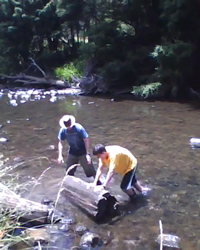

Species: Tanekaha (Phyllocladus trichomanoides).
The grain is straight and tight with distinct growth rings. Its colour is creamy yellow with streaks or dark toning due to it being a salvaged log of some 150+ years in a river. Conventional wisdom would suggest it is rather dense for a soundboard but it has other significant advantages. It is very elastic (the old bullock drivers used it for their long whip poles) and has excellent strength, which allows the top to be dimensioned a lot thinner than traditional spruces. This more than compensates for the added density and yields greater sustain than the spruces. Its tap tone is bright, powerful and direct. Coupled with Waingarara kauri bracing it produces a balanced, bright tone with plenty of volume. My high opinion of this tonewood is such that I used it on my 20th Anniversary models with superb results. Unfortunately, stock is very limited.
Motuhake
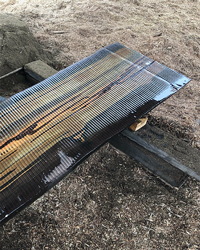

Species: Tanekaha (Phyllocladus trichomanoides).
No other log exemplifies the extraordinary degree of variation possible with NZ riverwood. Motuhake means unique, or special, and it is the name given to designate the tonewood produced from one particular river log which was actually determined to be a river fallen tree, as distinct from an old mill log, i.e. it fell of natural causes and was not cut down. Also tanekaha, the most striking distinction is its rich dark colour, in contrast to the normal colour of the species as seen above. Dark brown, almost black, with highlights of colour and sometimes streaks of light accents. The grain is smooth and has a silky luster that make this a very beautiful tonewood indeed. The properties of tanekaha make it a very versatile tonewood with Motuhake used primarily for back and sides. As such, it is a rival for any of the rosewoods and offers a more responsible alternative for those who love the look of the dark woods.
As an interesting side note, it is possible to hazard a guess at the age of this wood by factoring in the time it takes to stain the mill logs buried in the rivers. These logs colour from the circumference anywhere from 6 to 8 inches. Motuhake is coloured all the way through, which tells us it has been in the river many hundreds of years, at least 400 but it could be a lot more.
Producing great results as back and sides, it would also be possible to use Motuhake tonewood for soundboards.
Laurie has acquired the entire Motuhake tree and consequently stock levels are good.
River Rimu
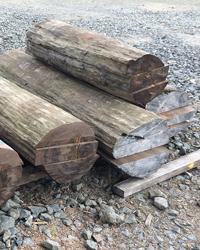
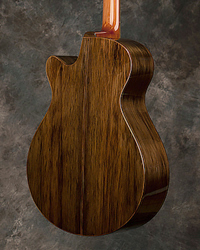
Species: Rimu (Dacrydium cupressinum).
One of the most common indigenous species used today for funiture and architectural components. A beautiful smooth grained timber with similar density to mahogany. The heartwood varies in colour from a dark reddish to yellowish brown, and often exhibits irregular streaks. The variety that occurs naturally with standing trees means there is a greater chance of finding some exceptional samples in future years though stock, at present, is limited to the sample shown here. Used for back, sides and necks. Stock levels adequate and more variety to come.
Totara
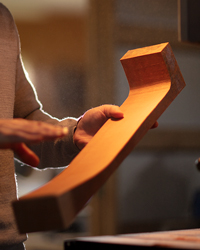

Species: Totara (Podocarpus Totara).
Totara is an important tree to the indigenous Mäori of New Zealand. Close grained and silky smooth, being easily worked with a carving chisel, it is the pre-eminent carving timber of New Zealand and was traditionally used for building waka (canoes) and decorative carving. A little difficult to dry but, once dry, is very stable, easily worked, and well suited to use as guitar necks. It makes a perfect alternative to Honduran mahogany. Clean, straight grain is easily obtained but the addition of dark staining and streaks can add character to a monotone neck or back and sides. Stock levels for necks is good. Nothing for back and sides at present.
